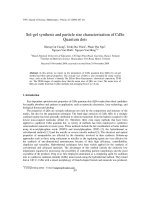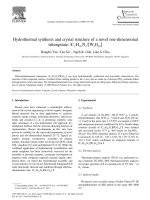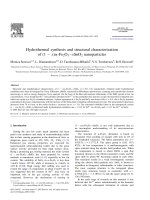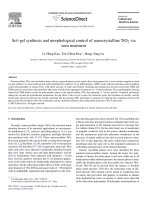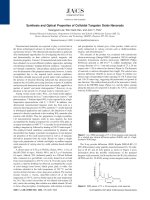- Trang chủ >>
- Khoa Học Tự Nhiên >>
- Vật lý
sol–gel synthesis and morphological control of nanocrystalline tio2 via urea treatment
Bạn đang xem bản rút gọn của tài liệu. Xem và tải ngay bản đầy đủ của tài liệu tại đây (1.1 MB, 8 trang )
Journal of Colloid and Interface Science 316 (2007) 160–167
www.elsevier.com/locate/jcis
Sol–gel synthesis and morphological control of nanocrystalline TiO
2
via
urea treatment
Li-Heng Kao, Tzu-Chien Hsu
∗
, Hong-Yang Lu
Institute of Materials Science and Engineering, National Sun Yat-Sen University, Kaohsiung 80424, Taiwan
Received 5 January 2007; accepted 18 July 2007
Available online 1 August 2007
Abstract
Nanocrystalline TiO
2
rods and hollow tubes with an engraved pattern on the surface have been prepared by a novel anionic template-assisted
sol–gel synthesis via urea treatment and under hydrothermal condition. X-ray diffractometry (XRD) results indicate that these nanocrystallines
consist predominantly of anatase TiO
2
, with minor amounts of rutile and brookite. Scanning and transmission electron microscopy (SEM and
TEM) analyses reveal these rods and hollow tubes may result from the aggregates of nanorods of ∼10 nm in diameter. The crystallographic faceting
found from TEM further reveals the polymorphic nature of the nanocrystalline TiO
2
thus prepared. A “reverse micelle” formation mechanism
taking into account the hydrothermal temperature, the pH effect of the sol–gel system, the isoelectric point, the formation of micelles, and the
electrostatic interaction between the anionic surfactant and the growing TiO
2
particulates is proposed to illustrate the competition between the
physical micelle assembly of the ionic surfactants and the chemical hydrolysis and condensation reactions of the Ti precursors.
© 2007 Elsevier Inc. All rights reserved.
Keywords: Nanocrystalline TiO
2
; Anionic template-assisted; Sol–gel; Urea; Hydrothermal; Reverse micelle; Isoelectric point; pH effect
1. Introduction
Recently, nanocrystalline titania (TiO
2
) has attracted much
attention because of its potential applications in environmen-
tal purification [1,2], catalysis and photocatalysis [3–5],gas
sensors [6], dielectric ceramics, pigments, and high efficiency
dye-sensitized solar cells [7–10]. These nanocrystalline TiO
2
have been prepared with various forms covering from nanopar-
ticles [11,12],thinfilms[13,14], nanotubes [15] to mesoporous
structure [16] and others [17–20]. In particular, nanoscale TiO
2
tubes and wires have attracted considerable attention because
they have large surface area and high photocatalytic activity
[20,21]. Nanotubular TiO
2
materials with diameters ∼10 nm
have received intensive attention due to its potential applica-
tions in the fields which are traditionally dominated by carbon
nanotubes. On the other hand, hollow fibers of TiO
2
with larger
outer diameter of 150–600 nm and aspect ratio of ∼30 prepared
with an amphiphilic supramolecular organogelator as the struc-
*
Corresponding author. Fax: +886 7 5250179.
E-mail address: (T C. Hsu).
ture directing agent has been reported. By self-assembling into
a fibrous structure, this agent acted as a template later in the sol–
gel polymerization of the titanium precursors to become hol-
low tubular titania [22]. On the other hand, use of membranes
in template synthesis such as the porous alumina membranes
and the nanoporous track-etch polymeric membranes in the
presence of certain additives has also received intensive atten-
tion [23]. In this approach, the pores within these nanoporous
membranes play the same role as the templated surfactants in
controlling nanostructures of the desired materials.
Various crystalline phases have been identified for these
reported nanocrystalline titania. Among the major five poly-
morphs of titania, the rutile phase is the most stable one at all
temperatures under ambient pressure; the anatase phase is meta-
stable; the brookite phase is the least stable one; whereas TiO
2
-
II and TiO
2
-III can be derived from the anatase or brookite
phase under pressure. TiO
2
-B is the monoclinic form of tita-
nium dioxide. This mineral can be found in weathering rims
on tektite and perovskite and appears as lamellae in anatase
from hydrothermal veins; its density is much lower than that
of the other three polymorphs. Polymorphic transformations of
0021-9797/$ – see front matter © 2007 Elsevier Inc. All rights reserved.
doi:10.1016/j.jcis.2007.07.062
L H. Kao et al. / Journal of Colloid and Interface Science 316 (2007) 160–167 161
anatase to rutile and of brookite to rutile do not take place re-
versibly [24].
It is generally claimed that the sol–gel synthesis of ceramic
oxides offers advantages such as high purity, good homogene-
ity, low processing temperature, and also the possibility of mak-
ing new nanocrystalline solids outside the range of normal glass
formation [25,26]. Factors affecting the ultimate properties of
ceramic materials in a typical sol–gel process may include the
type of solvent, the reactivity of metal precursor, pH of the re-
action medium, and reaction temperature, among many factors
[27,28]. By controlling these material or processing parameters,
different surface chemistry and microstructure of ceramic ox-
ides can be obtained. However, the precipitates derived by sol–
gel synthesis are typically amorphous; this requires a high tem-
perature heat treatment to induce the crystallization during the
post-gel stage. On the other hand, hydrothermal synthesis has
been carried out at a relatively low temperature (<250
◦
C) to
produce sufficiently crystalline ceramic solids as compared to
calcination [26,29,30]. In the hydrothermal synthesis, morphol-
ogy, composition, structure, grain size, and crystalline phase
can be controlled by changing the hydrothermal parameters
such as reaction temperature and pressure, pH values, sol com-
position, type of the solvent and additive, and the aging time
[11,31,32]. Among these processing parameters, the hydrother-
mal temperature is regarded as the most crucial one since it
controls the steam pressure of this closed aqueous system.
It has been reported that the addition of liquid ammonia in
the sol–gel synthesis of some inorganic oxides may result in
precipitation. Yada et al. [33] obtained a hexagonal structure
alumina by a homogeneous precipitation method using urea,
from which the ammonia was generated at an elevated tem-
perature. Banerjee et al. [34] employed urea as the hydrolyz-
ing agent to control the hydrolysis rate in the preparation of a
hexagonal mesoporous nickel oxide. To our best understand-
ing, the urea approach has not been applied to the preparation
of TiO
2
nanotubes. However, a different surfactant-mediated
template laurylamine hydrochloride was adopted by Peng et
al. [35], which resulted in a TiO
2
tubules with mesostructural
walls, the outer diameter and the wall thickness of the tita-
nia microtubules being 2–8 and 0.2–2 µm. We report in this
study a novel anionic template-assisted sol–gel approach via
urea treatment and under hydrothermal condition for synthe-
sizing the nanocrystalline TiO
2
rods and hollow tubes, con-
sisting of aggregates of nanorods of ∼10 nm in diameter. The
nanocrystalline TiO
2
thus prepared appears to have an engraved
surface morphology and consists mainly of the anatase and mi-
nor amount of rutile and brookite. It is also demonstrated that
microstructure and phase content of the nanocrystalline TiO
2
can be tailor-made by properly manipulating those parame-
ters during the combined sol–gel and hydrothermal process-
ing.
2. Experimental
Titanium tetrachloride (TiCl
4
; 99.9%, Acros) was used as
the titanium source; sodium dodecyl sulfate (SDS, CH
3
(CH
2
)
11
OSO
3
Na; 99%, Aldrich) and urea (H
2
NCONH
2
; 98%, Acros)
were used as received. Urea was employed as a hydrolysis agent
to control the hydrolysis rate, it was also used in this work to
control the pH value of sol–gel system by a hydrolysis reaction
(Eq. (1)) at a temperature greater than 80
◦
C, from which the
ammonia could be generated [34]:
(NH
2
)
2
CO + 3H
2
O → 2NH
+
4
+ 2OH
−
+ CO
2
.(1)
A specific amount of SDS was first dissolved in deionized
(DI) water and mixed with urea. TiCl
4
was then added dropwise
to this highly viscous aqueous solution with rigorous stirring.
Caution on the quick release of HCl should be taken when TiCl
4
was added, due primarily to its extreme sensitivity to the mois-
ture. TiCl
4
, SDS, urea, and DI water were mixed in a molar
ratio of 1:2:30:60. The mixture was stirred at 40
◦
Cfor1hto
yield a transparent solution. The solution was then heated un-
til the pH had increased to 2.2; it was immediately transferred
into a sealed Teflon-coated autoclave and was further heated at
an elevated hydrothermal temperature for 48 h. The pH value
of the final white slurry thus prepared was 5.6 (90
◦
C), 8.52
(120
◦
C), 9.12 (150
◦
C), and 10.6 (180
◦
C). Since the autoclave
is a closed system under high temperature and high pressure, it
is not feasible to dynamically measure the pH values in situ dur-
ing the sol–gel process. Instead of estimating the dynamics of
the pH during hydrothermal treatment, an alternative approach
was adopted. The sol–gel reaction was terminated after 24 h and
the pH value was measured. It was found for all the four sam-
ples the pH values at 24 h had reached a value as high as that of
at 48 h, indicating that effect of ammonia on the microstructure
was mostly profound in the first half period of the hydrothermal
treatment.
The measured autogenous pressures inside the autoclave un-
der different hydrothermal temperatures were 0.92 bar (90
◦
C),
2.1 bar (120
◦
C), 5.13 bar (150
◦
C), and 10.97 bar (180
◦
C),
which are very close to the values estimated from ASME
Steam Tables (0.70 bar (90
◦
C), 1.99 bar (120
◦
C), 4.76 bar
(150
◦
C), and 10.03 bar (180
◦
C)) [36]. The product was re-
peatedly washed with DI water to remove the organic moieties,
filtered with a 0.45 µm filter paper, and then dried in air. It
was then calcined at 800
◦
C (at a heating rate of 4
◦
C/min) for
4 h in air to further remove the residual organic moieties. The
calcined product was then re-washed with DI water to remove
water-soluble impurities such as sodium sulfate formed during
calcination.
Crystalline phases were determined by the X-ray diffractom-
etry (XRD, Siemens D-5000, Karshrule, Germany) with CuKα
radiation and Ni filter operating at 40 kV/30 mA. Microstruc-
ture was analyzed by the field-emission scanning electron mi-
croscopy (FE-SEM, JEOL™ 6330, Tokyo, Japan) operating at
20 kV. Sample for SEM was first mounted onto a carbon adhe-
sive pad which was attached to an aluminum stub, it was then
air-dried and gold-coated (Pelco SC-6 sputter-coater). Samples
ultrasonicated and filtered on holey carbon grids were exam-
ined by the transmission electron microscopy (TEM, JEOL™
AEM 3010, Tokyo, Japan) operating at 200 kV.
162 L H. Kao et al. / Journal of Colloid and Interface Science 316 (2007) 160–167
3. Results and discussion
3.1. Phase identification
The XRD patterns of the as-prepared nanocrystalline TiO
2
samples synthesized under different hydrothermal conditions
shown in Fig. 1 reveal diffraction peaks of (101), (004), (200),
and (211), which are characteristic of the anatase phase. The
relative broad peaks suggest low crystallinity among the four
samples measured; the crystallinity increases with increasing
hydrothermal temperatures. The result is quite different from
the traditional (or typical) sol–gel process in which only amor-
phous phase can be obtained from the precipitates derived by
sol–gel process before calcinations; and further higher temper-
ature heat treatment is normally required to induce crystalliza-
tion. Thus, the hydrothermal treatment may be regarded as an
alternative to calcination for promoting the crystallization [11].
A minor diffraction peak assigned as the rutile (110) found in
sample SDS-90 can also discernibly be identified from Fig. 1.
XRD patterns of calcined nanocrystalline TiO
2
prepared un-
der different hydrothermal conditions are shown in Fig. 2.Dif-
fraction peaks of anatase (tetragonal, I 4
1
/amd (No. 141)), ru-
tile (tetragonal, P 4/mnm (No. 136)) and brookite (orthorhom-
bic, Pcab (No. 61)) (corresponding to JCPDS No. 21-1272,
21-1276 and 29-1360, respectively) are identified unambigu-
ously. The fact that no discernible peak was identified in the
low range of 2θ = 1–10
◦
has ruled out the existence of the
amorphous mesoporous structure [37,38]. This is contradictory
to what was expected in our initial design of experiments and
is also inconsistent with those reported in the literature [34,39].
An amorphous mesoporous structure would usually be formed
in the sol–gel-derived ceramic oxides prepared by the assistance
of ionic template without any hydrothermal treatment. It can be
postulated that this hydrothermal treatment in this study has a
profound effect on the ultimate microstructure of the nanocrys-
talline TiO
2
.
Summarized in Table 1 are the phase contents determined
from the integrated XRD peak intensities of anatase (101), ru-
tile (110), and brookite (121) by a numerical deconvolution
method [40]; also listed are the crystallite sizes calculated by
Scherrer equation. It is obvious that the crystallite sizes un-
der various hydrothermal conditions change considerably; but
most are within the range of 30–50 nm, except for SDS-150
(∼13 nm). Table 1 also indicates that the meta-stable anatase is
the dominant phase for all the samples; other minor phases in-
clude the more stable rutile (for the low-temperature samples)
and the least stable brookite (for the high-temperature samples).
Thus, increasing hydrothermal temperature seems to encour-
age a phase transformation from rutile to brookite, while phase
content of anatase remains roughly the same. The results are
consistent with the reported findings [25]; it was argued that
the dissolution of an acidified titania sol at low temperatures
was slow, resulting in a slow crystallization. This crystallization
process would be governed by the thermodynamics, not the ki-
netics; therefore, the most stable rutile phase should be formed
at low hydrothermal temperatures. On the other hand, the meta-
stable anatase or brookite should be the favorable phases under
higher hydrothermal temperatures, due kinetically to a faster
dissolution and a more rapid precipitation.
3.2. Morphological characterization
Under a lower magnification, FE-SEM image for SDS-90
shown in Fig. 3a reveals a long fibrous structure with an as-
pect ratio ∼30, a value much higher than those reported data
which are typically less than 10 [18,19]; an engraved pattern
on the surface of SDS-90 sample is also discernible in Fig. 3b,
not found in the other samples prepared at higher hydrothermal
Fig. 1. XRD patterns of nanocrystalline TiO
2
rods and hollow tubes prepared at four hydrothermal temperatures indicated; samples measured before calcination.
Patterns were compared to the JCPDS data (F: rutile); “s” and “u” denote peaks corresponding to SDS and urea, respectively.
L H. Kao et al. / Journal of Colloid and Interface Science 316 (2007) 160–167 163
Fig. 2. XRD patterns of nanocrystalline TiO
2
rods and hollow tubes prepared at four hydrothermal temperatures indicated; samples measured after calcination.
Patterns were compared to the JCPDS data (F: rutile; ": brookite).
Table 1
Summary of phase contents and crystallite sizes
Material Anatase Rutile Brookite
Crystallite size (nm)
a
Content (%)
b
Crystallite size (nm)
a
Content (%)
b
Crystallite size (nm)
a
Content (%)
b
SDS-90 44.088.746.611.3– –
SDS-120 47.087.842.33.438.58.7
SDS-150 13.474.4– – 12.625.6
SDS-180 49.988.5– – 32.011.5
a
Calculated by Scherrer equation.
b
Calculated using the equation in Ref. [38].
Fig. 3. FE-SEM images of nanocrystalline TiO
2
rods and hollow tubes (a) and the engraved surface (b) for SDS-90.
164 L H. Kao et al. / Journal of Colloid and Interface Science 316 (2007) 160–167
Fig. 4. FE-SEM images of nanocrystalline TiO
2
rods, hollow tubes, and platelets prepared at different hydrothermal temperatures: (a) SDS-90, (b) SDS-120,
(c) SDS-150, and (d) SDS-180.
temperatures. Note that SDS-90 maintained a pH value under
the isoelectric point (IEP) of TiO
2
(∼5.8) during its sol–gel
synthesis. A closer examination on SDS-90 is given in Fig. 4a,
from which a well defined rod-like or hollow-tube-like mor-
phology can be identified with the rod diameter of 50–300 nm
and the hollow tube diameter of 200–600 nm (all have an aspect
ratio ∼30); note that some nanorods of ∼10 nm and with the
same aspect ratio in diameter can also be discernibly identified.
The morphology found here is very similar to those reported
TiO
2
hollow fibers which adopted an amphiphilic compound
and without hydrothermal treatment [22,40,41]. In our case, an
anionic surfactant SDS was adopted as the liquid crystal tem-
plate; then the base-catalyzed sol–gel synthesis was followed
under hydrothermal conditions. Due to the high temperature
and high pressure in the autoclave under the hydrothermal con-
dition, a completely different reaction mechanism and forma-
tion sequence of liquid crystal template and sol–gel synthesis
may be rationalized. The steam is generated under high temper-
atures to produce a hydrostatic pressure which in turn imposes
a profound effect on the ultimate microstructure of the ceramic
oxides thus prepared. This autogenous hydrostatic pressure can
be as high as 11 bars under a hydrothermal temperature of
180
◦
C (exact values can be found in Section 2). Therefore, it
can be said that in this aqueous system in the sealed autoclave,
the temperature has much higher impact on the sol–gel reaction
rate, the morphology, as well as the reaction mechanism.
When the hydrothermal temperature is increased, it is ob-
served from Fig. 4 that the rods and hollow tubes are gradually
transformed into a tabular or platelet structure, possibly due
to the autogenous pressure generated under hydrothermal con-
ditions. Note that the pH value for SDS-120, SDS-150, and
SDS-180 during their sol–gel processing was above the IEP
of TiO
2
. These tabular or platelet structures remain almost the
same physical size as the rods and tubes (same aspect ratio).
The straight and parallel stripes (referred to Figs. 4b and 4c)on
the surface of the rods and hollow tubes may result from the
aggregates of the smaller and finer nanorods of ∼10 nm in di-
ameter [31,32].
L H. Kao et al. / Journal of Colloid and Interface Science 316 (2007) 160–167 165
Fig. 5. TEM images of nanocrystalline TiO
2
hollow tubes and platelets prepared at different hydrothermal temperatures: (a) SDS-90, (b) SDS-120, (c) SDS-150,
and (d) SDS-180.
Shown in Fig. 5a is a TEM image of hollow tube with an
outer diameter of ∼600 nm and an inner diameter of ∼200 nm
for SDS-90, in addition to the rods found from SEM (Fig. 4a).
The yield of the TiO
2
nanotubes and nanorods synthesized from
their precursors is estimated from stoichiometric calculation to
be 81%; meanwhile the ratio between the hollow tubes to the
rods is estimated from the SEM image to be about 1/5. The
clear parallel and straight stripes appeared on the surface of the
rod, tube, and platelet in Figs. 5a–5c are in fact the crystallo-
graphic faceting that occurs due to anisotropic (solid-to-vapor)
surface energy. This faceting exists because atoms are packed
in different density along crystal planes, e.g., fcc close-packed
plane on {111} along 110. Likewise for TiO
2
, regardless of
its polymorphs (the anatase is the dominant phase from XRD
results in this study), would have different atomic packing den-
sity, and so faceting appears. Crystals with different structure
usually appear faceted. On the other hand, these stripes may be
the aggregates of nanorods as suggested from SEM observa-
tions.
With increasing hydrothermal temperatures, the rod or the
tube gradually transform into a tabular or platelet structure
(Figs. 5c, 5d). These TEM images show consistent results as
the SEM in Fig. 3. When proper chemicals are inserted inside,
these types of TiO
2
rods and hollow tubes may possess potential
applications due to their unusual catalytic, electric, and optical
properties.
3.3. Formation mechanism
In sol–gel synthesis using transition metal chlorides as the
precursors, hydrolysis and condensation reactions take place
very rapidly [37,42,43]. In preparing TiO
2
using SDS as the an-
166 L H. Kao et al. / Journal of Colloid and Interface Science 316 (2007) 160–167
Fig. 6. Formation of nanocrystalline TiO
2
rods and hallow tubes is favorable at lower temperatures when the pH value is below IEP of TiO
2
(path I); while higher
temperatures encourage the formation of a tabular structure of TiO
2
(path II).
ionic surfactant under basic conditions with urea, the formation
of SDS micelles as the templates may have to compete with the
hydrolysis and condensation of Ti precursors. At a hydrother-
mal temperature of 90
◦
C in which the basic urea has not been
able to completely release its hydroxyl ions, the reaction system
appears to have a pH value below IEP of TiO
2
, thus allowing
a positively charged TiO
2
surface due to rapid hydrolysis and
condensation. The negatively charged SDS micelles originally
present in the system are now forced to break down and are
attached to the positive TiO
2
surface, forming the so-called “re-
versed micelle” (path I in Fig. 6). These SDS-coated TiO
2
parti-
cles then aggregate into stacked TiO
2
nanorods; further calcina-
tion at higher temperatures results in the nanocrystalline TiO
2
rods and hollow tubes. Another possible mechanism of chemi-
cally induced self-transformation of amorphous solid particles
to account for the fabrication of hollow inorganic microspheres
has been mentioned [17]. This approach was based on mor-
phologically confined processes of Oswald ripening where no
sacrificial surfactant template was involved. The profound ef-
fect found in this study on the microstructure due to the pres-
ence of urea, from which ammonia is chemically produced,
can also be regarded as a result of chemically induced phase
transformation. On the other hand, the “reverse micelle” mech-
anism was associated with certain anionic surfactant-templated
sol–gel processes such as dodecyl sulfate (SDS) and sodium
bis(2-ethylhexyl) sulfosuccinate; note that no urea was involved
in the morphological control of TiO
2
materials in these studies
and that the particle sizes thus prepared are within the approxi-
mately same range as in this study [44–46].
It can now be rationalized that the engraved pattern in Fig. 3b
may result from the complete destruction of the anionic organic
surfactants SDS on the surface of the nanocrystalline TiO
2
dur-
ing calcination. Initially, SDS was designed to self-assemble
into a template upon which sol–gel reaction was expected to
take place subsequently, an approach similar to the process of
the commercially available MCM-41 silica. Obviously, the ob-
served morphology is not consistent with the generally accepted
formation mechanism of the typical liquid crystal template-
assisted sol–gel synthesis of ceramic powders. The anionic sur-
factants appear to have altered the reaction kinetics of hydroly-
sis and condensation of Ti precursors.
On the other hand, at higher hydrothermal temperatures, a
complete urea reaction encourages a basic sol–gel reaction sys-
tem; this allows the surface of TiO
2
to be negatively charged
because the pH of the sol–gel system is now above the IEP of
TiO
2
. Therefore, the also negatively charged SDS micelles are
incompatible to the TiO
2
particles and are excluded from the
sol–gel processing of TiO
2
upon further condensation (path II
in Fig. 6). Without the constraint of the reverse micelles by the
rejected SDS molecules, formation of rods and hollow tubes
becomes unfavorable and a plate-like morphology with a rough
surface may form after the hydrothermal treatment. Further cal-
cination results in the nanocrystalline TiO
2
platelets as shown
in Figs. 4d and 5d.
4. Conclusions
A novel approach adopting the anionic template-assisted
sol–gel synthesis via urea treatment and under hydrothermal
processing to synthesize the nanocrystalline TiO
2
rods and hol-
low tubes has been demonstrated in this study. Similar hol-
low tubes with same range of diameters have been reported
but using a completely different amphiphilic surfactant. In-
stead of an amorphous as is reported in most sol–gel-derived
ceramic oxides before calcinations, the as-prepared nanocrys-
talline TiO
2
has an anatase phase, although with a low degree
of crystallinity. The calcined nanocrystalline TiO
2
is found to
be mostly anatase, with minor amount of rutile and brookite.
L H. Kao et al. / Journal of Colloid and Interface Science 316 (2007) 160–167 167
Low hydrothermal temperatures are found to favor the forma-
tion of TiO
2
rods and hollow tubes, both may result from the
aggregates of TiO
2
nanorods. The pH value of the reacting
sol–gel system plays a crucial role in determining the charge
on the surface of the reacting TiO
2
particles. The pH value
of the sol–gel system under lower hydrothermal temperature is
found to below IEP of TiO
2
such that the surface charge of the
anatase TiO
2
particles becomes positive. This forces the SDS
micelles to form a coating on the TiO
2
particles due to elec-
trostatic attraction. This “reverse micelle” mechanism results in
the formation of the nanocrystalline TiO
2
rods or hollow tubes.
Upon calcinations at higher temperatures as the surfactant SDS
is incinerated, an engraved TiO
2
surface is found. Since higher
hydrothermal temperatures encourage the urea reaction to re-
lease the hydroxyl ions, the sol–gel system becomes more basic
and its pH value is far exceeding the IEP of TiO
2
. The neg-
atively charged SDS micelles are thus rejected from the also
negatively charged TiO
2
particle, resulting in a tabular TiO
2
structure. These types of TiO
2
rods and hollow tubes, when
proper chemicals are inserted inside, may possess potential ap-
plications due to their unusual catalytic, electric, and optical
properties.
Acknowledgments
This work was funded by the National Science Council of
Taiwan through contract NSC-93-2216-E-110-012. One of the
authors (L.H.K.) wishes to thank C.L. Chang for his help with
FE-SEM, and Dr. Y.C. Wu of National Taipei University of
Technology for her help with TEM.
References
[1] W. Choi, M.R. Hoffmann, Environ. Sci. Technol. 31 (1997) 89.
[2] Q. Dai, Z. Zhang, N. He, P. Li, C. Yuan, Mater. Sci. Eng. C 8–9 (1999)
417.
[3] B. Sun, P.G. Smirniotis, Catal. Today 88 (2003) 49.
[4] G. Dagan, M. Tomkiewicz, J. Phys. Chem. 97 (1993) 12651.
[5] X. Hong, Z. Wang, W. Cai, F. Lu, J. Zhang, Y. Yang, N. Ma, Y. Liu, Chem.
Mater. 17 (2005) 1548.
[6] N. Savage, B. Chwieroth, A. Ginwalla, B.R. Patton, S.A. Akbar, P. Dutta,
Sens. Actuators B 79 (2001) 17.
[7] U. Bach, D. Lupo, P. Comte, J.E. Moser, F. Weissortel, J. Salbeck, H. Spre-
itzer, M. Gratzel, Nature 395 (1998) 583.
[8] M. Adachi, Y. Murata, J. Takao, J. Jiu, M. Sakamoto, F. Wang, J. Am.
Chem. Soc. 126 (2004) 14943.
[9] H. Luo, T. Takata, Y. Lee, J. Zhao, K. Domen, Y. Yan, Chem. Mater. 16
(2004) 846.
[10] S. Nakade, Y. Saito, W. Kubo, T. Kitamura, Y. Wada, S. Yanagida, J. Phys.
Chem. B 107 (2003) 8607.
[11] C.C. Wang, J.Y. Ying, Chem. Mater. 11 (1999) 3113.
[12] H. Yu, J. Yu, B. Cheng, J. Mol. Catal. A 253 (2006) 99.
[13] N. Negishi, K. Takeuchi, T. Ibusuki, J. Mater. Sci. Lett. 18 (1999) 515.
[14] D. Grosso, J. Galo, A.A. Soller-Illia, Adv. Mater. 13 (2001) 1085.
[15] J. Yu, H. Yu, Mater. Chem. Phys. 100 (2006) 507.
[16] M. Anderson, H. Birkedal, N.R. Franklin, T. Ostomel, S. Boettcher,
A.E.C. Palmqvist, G.D. Stucky, Chem. Mater. 17 (2005) 1409.
[17] J. Yu, H. Guo, S.A. Davis, S. Mann, Adv. Funct. Mater. 16 (2006) 2035.
[18] P.D. Cozzoli, A. Korrowski, H. Weller, J. Am. Chem. Soc. 125 (2003)
14539.
[19] T. Kasuga, M. Hiramatsu, A. Hoson, T. Sekino, K. Niihara, Langmuir 14
(1998) 3160.
[20] B.B. Lakshmi, C.J. Patrissi, C.R. Martin, Chem. Mater. 9 (1997) 2544.
[21] E.K. Kyriaki, E.V. Xenophon, J. Phys. Chem. 97 (1993) 1184.
[22] S. Kobayashi, K. Hanabusa, N. Hamasaki, M. Kimura, H. Shirai, S.
Shinkai, Chem. Mater. 12 (2000) 1523.
[23] J.C. Hulteen, C.R. Martin, J. Mater. Chem. 7 (1997) 1075.
[24] J.L. Murray, H.A. Wriedt, Phase Diagrams of Binary Titanium Alloys,
ASM International, Metals Park, OH, 1987.
[25] B.L. Bischoff, M.A. Anderson, Chem. Mater. 7 (1995) 1772.
[26] C.C. Wang, J.Y. Ying, Chem. Mater. 11 (1999) 3113.
[27] C.J. Brinker, G.W. Scherer, Sol–Gel Science, Academic Press, San Diego,
1990.
[28] L.C. Klein, Sol–Gel Technology for Thin Films, Fibers, Preforms, Elec-
tronics, and Specialty Shapes, Noyes Publications, New Jersey, 1987.
[29] M. Wu, J. Long, A. Huang, Y. Luo, Langmuir 15 (1999) 8822.
[30] K. Yanagisawa, J. Ovenstone, J. Phys. Chem. B 103 (1999) 7781.
[31] Q. Zhang, L. Gao, Langmuir 19 (2003) 967.
[32] L. Kavan, M. Kalbac, M. Zukalova, I. Exnar, V. Lorenzen, R. Nesper,
M. Graetzel, Chem. Mater. 16 (2004) 477.
[33] M. Yada, M. Machida, T. Kijima, Chem. Commun. (1996) 769.
[34] S. Banerjee, A. Santhanam, A. Dhathathreyan, P.M. Rao, Langmuir 19
(2003) 5522.
[35] T. Peng, A. Hasegawa, J. Qie, K. Hirao, Chem. Mater. 15 (2003) 2011.
[36] J.M. Smith, H.C. Van Ness, Introduction to Chemical Engineering Ther-
modynamics, McGraw–Hill International, New York, 1987.
[37] D.M. Antonelli, J.Y. Ying, Angew. Chem. Int. Ed. Engl. 34 (1995) 2014.
[38] P. Yang, D. Zhao, D.I. Margolese, B.F. Chmelka, G.D. Stucky, Nature 396
(1998) 152.
[39] D.M. Antonelli, Micropor. Mesopor. Mater. 30 (1999) 315.
[40] H. Zhang, J.F. Banfield, J. Phys. Chem. 104 (2000) 3481.
[41] P.C.A. Alberius, K.L. Frindell, R.C. Hayward, E.J. Kramer, G.D. Stucky,
B.F. Chmelka, Chem. Mater. 14 (2002) 3284.
[42] E.L. Crepaldi, G.J.A.A. Soller-Illia, D. Grosso, F. Cagnol, F. Ribot,
C. Sanchez, J. Am. Chem. Soc. 125 (2003) 9770.
[43] P. Yang, D. Zhao, D.I. Margolese, B.F. Chmelka, G.D. Stucky, Chem.
Mater. 11 (1999) 2813.
[44] S.H. Kang, I. Hirasawa, W S. Kim, C.K. Choi, J. Colloid Interface
Sci. 288 (2005) 496.
[45] J.D. Hopwood, S. Mann, Chem. Mater. 9 (1997) 1819.
[46] M. Li, S. Mann, Adv. Funct. Mater. 12 (2002) 773.


